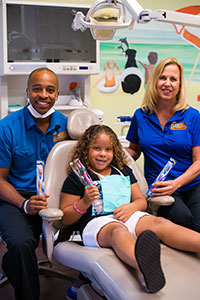Cavity Prevention for Little Ones
 Preventing decay, infection and other dental problems is a group effort between our team members, you and your child. Below are some tips for home care and information on office procedures that can help you avoid dental problems before they begin.
Preventing decay, infection and other dental problems is a group effort between our team members, you and your child. Below are some tips for home care and information on office procedures that can help you avoid dental problems before they begin.
Dental Care at Home
Home care consists of brushing, flossing and diet.
Elmo Sings Healthy Teeth, Healthy Me Elmo Teaches Us How to Brush
Brushing and Flossing
Home care should start at birth by regularly cleaning your baby's mouth with a soft cloth or infant toothbrush and water.
As soon as the first tooth appears, start brushing gently two times a day for 2-3 minutes. Use an infant-sized brush with soft, rounded bristles and just a dab of non-fluoride toothpaste.
How to Brush
1. Place the toothbrush at a 45-degree angle to the gum line. Brush each tooth in a small circular motion, one tooth at time.
2. Brush across the chewing surfaces, making sure the bristles get into the grooves and crevices.
3. Clean the side of the teeth that face the tongue using the same circular motion.
4. Brush your child's tongue lightly to remove bacteria and keep breath smelling good.
5. Have your child rinse his or her mouth with water.
At the age of two, you can start using a pea-sized amount of paste. Let your child brush on their own when they are ready, but be sure to help with the areas they miss.The toothbrush should be replaced every 3 months or sooner if the bristles are frayed.
You should begin flossing your child's teeth once any two teeth touch. Floss by sliding the floss between the teeth and against the side of the tooth. Slide the floss up to the gum and down several times, then do the same against the other tooth.
 Diet and Snacking
Diet and Snacking
A balanced diet is crucial for the proper development of your child's teeth, as well as the health of the surrounding tissues. A healthy diet includes dairy products, proteins, fruits, vegetables and whole grains.
The amount of starches and sugars eaten also affect your child's dental health. Bacteria thrive on starches such as breads, pastas and chips as well as sugars such as in juices and desserts. These bacteria then attack the tooth surface, resulting in decay. Sticky foods also stay on the tooth longer, feeding bad bacteria and creating cavities.
You do not need to remove all sugar and starch from the diet. For instance, milk is an important source of the calcium and it also contains sugar. Rather, you should try to limit snacking between meals and choose nutritious options.
Avoiding "Baby Bottle Caries"
As mentioned above, milk contains sugars that can cause decay. For this reason, tooth decay is common in young children but can be avoided by following a few tips:
- Avoid giving milk or other drinks in the bottle or sippy cup at night.
- Avoid nursing children to sleep or wipe teeth clean before putting them to bed.
- Do not put honey or sugar on pacifiers.
- Avoid "at-will" breast feeding once the first teeth have erupted.
- Start dental visits by your child's first birthday.
- Begin weaning your child off the bottle around 1 year of age. If transitioning to a sippy cup, give only at meal and snack time and avoid "at will" use.
In-Office Prevention
Regular office visits (every 6 months) will allow us to diagnose and treat any problems early. Office visits also include a teeth cleaning, fluoride/varnish treatments and nutritional counseling.
We may also recommend sealants. Sealants fill in the thin grooves or pits in teeth that the toothbrush cannot reach and that are particularly prone to decay.
We check growth and development and may recommend an orthodontic consultation if the child's bite (occlusion) needs some adjusting. If the child has a thumb habit we may also suggest a visit to the orthodontist for a thumb sucking appliance to be placed.








 941-792-9392
941-792-9392





